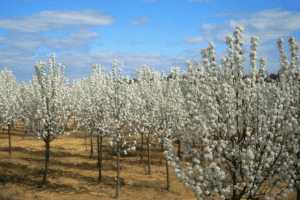 Conservation efforts to promote native habitat hardly ever make national headlines, but they have been a consistent part of both federal and state government initiatives for decades. However, if you live in states such as Missouri, Kansas, and Virginia, you may have seen your state government take up environmental legislation this past week against the Bradford pear tree, an invasive tree that gained its fame for a particularly foul smell and is already restricted in ten other states.
Conservation efforts to promote native habitat hardly ever make national headlines, but they have been a consistent part of both federal and state government initiatives for decades. However, if you live in states such as Missouri, Kansas, and Virginia, you may have seen your state government take up environmental legislation this past week against the Bradford pear tree, an invasive tree that gained its fame for a particularly foul smell and is already restricted in ten other states.
Bills introduced in state legislatures ranged from those offering trade-in programs, giving landowners native trees in exchange for Bradford pear trees in Virginia, to an all-out ban on the sale of the tree and other invasive vegetation in HB 2412 introduced in the Missouri House of Representatives.1 State politicians cite a number of reasons for bringing forward these policies, including the difficulty native plants have competing with invasive species and the unwillingness of the general public to commit to growing native plants on their land.
North America has been on a steady path of natural habitat loss since early colonization, with some of the largest causes being agriculture, climate change, and land conversion for development.2 Farming practices have largely relied on foods that are not naturally grown in our ecosystem or have been genetically altered to grow in mass quantities. Conservationists have seen this result in detrimental land erosion and natural habitat loss for native animal species.
In the 19th century, the United States saw a boom in land development along coastal regions, replacing what was once marshlands with private and commercial buildings.3 Florida, a state on the front lines of climate change, has seen its wetlands decrease by 44 percent since becoming a state.4 As the ocean rises and the southeastern part of the country experiences more extreme storms, landowners can see their land wash away, as they rarely continue to plant vegetation with root systems that can retain the water flooding their land, instead opting for plants that have a decorative appeal over the natural long grasses that once grew along the beaches. While the Florida Department of Fish and Wildlife works to restore wetlands on public land, state laws make it difficult to enforce conservation policies on privately owned land.
At the federal level, there are a number of government entities that work to address the issue of native habitat loss, including the National Park Service, the U.S. Fish and Wildlife Service, the U.S. Forest Service, the Natural Resources Conservation Service, and the U.S. Geological Survey. While these agencies have their own projects and initiatives, much of the work that’s done through these government organizations is done through grant opportunities provided to state agencies, research institutions, and nongovernmental organizations. The funding is created by acts of Congress, such as the recent Infrastructure Investment and Jobs Act (which promised to mitigate the impacts of climate change) and the longstanding North American Wetlands Conservation Act of 1989 which still funds work done today.
While there are many organizations dedicated to the cause of conservation efforts, bills working to address the issue hardly ever survive the partisan politics of federal and state government initiatives. Opposing lawmakers cite the rights of property owners and argue that such bills are not an issue of importance for the government to invest in financially. Others cite conservation as a cultural issue and have taken to education and social media to combat apathy toward the issue. Once such organization is the Native Habitat Project based in northern Alabama, which has skyrocketed in popularity on TikTok and Instagram, with over 424,000 followers. The group seeks to educate the public on natural habitat loss and conservation efforts in the hopes that individuals will take up the cause of protecting their local forests, marshes, and prairie lands.5
Whether you agree that conservation is a political issue or a cultural issue, we will soon see a different reality of what native habitat looks like in North America, with the effects of climate change becoming more apparent each year.
Discussion Questions
- Is wildlife and habitat conservation an issue the government should prioritize? Why or why not? Is this an issue that should be addressed culturally instead? Why or why not?
- Should the government seek natural solutions to combat climate change, such as restoring wetlands? Why or why not?
- Should the government have the authority to address this issue on private property as well as on public lands? Why or why not?
- If conservation was an issue that you prioritized, how might you motivate the public to invest in habitat restoration?
As always, we encourage you to join the discussion with your comments or questions below.
Close Up is proud to be the nation’s leading nonprofit civic education organization, working with schools and districts across the country since 1971. If you would like to partner with us or learn more about our experiential learning programs, professional development, or curriculum design and consulting, contact us today!
Sources
Featured Image Credit: STLIPR/NPR photographer Mangrove Mike
[1] USA Today: https://www.usatoday.com/story/news/nation/2024/03/25/bradford-pear-trees-smell-invasive-species-banned/73040722007/; National Public Radio: https://www.stlpr.org/health-science-environment/2024-04-05/missouri-arbor-day-exchanging-bradford-pear-trees-less-invasive
[2] National Wildlife Federation: https://www.nwf.org/Educational-Resources/Wildlife-Guide/Threats-to-Wildlife/Habitat-Loss
[3] NOAA Shoreline: https://shoreline.noaa.gov/intro/index.html
[4] Florida Fish and Wildlife Conservation Commission: https://myfwc.com/conservation/freshwater/wetland-habitat/
[5] Native Habitat Project: https://www.nativehabitatproject.com/
 One hundred sixty ESOL high school students from Lee County Public Schools recently presented their Florida Legislative Proposals, in the very first Lee County Youth Policy Summit Expo.
One hundred sixty ESOL high school students from Lee County Public Schools recently presented their Florida Legislative Proposals, in the very first Lee County Youth Policy Summit Expo.







